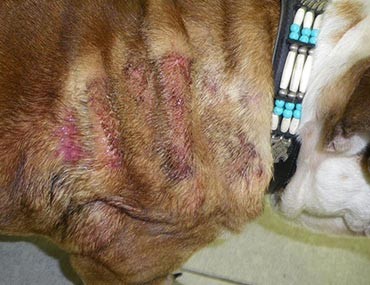Overview of hot spots
Hot spots, technically called acute moist dermatitis or superficial canine pyoderma, usually appear as localized, moist, reddish sores. Hot spots are the result of a bacterial infection: something irritates your dog’s skin and the irritation becomes itchy, so your dog does the logical thing—scratch, lick, or both—eventually causing a red, ugly oozing sore.
Risk of hot spots
So what causes your dog to be itchy in the first place? Itchy skin can be caused by a variety of things, such as allergies to food or the surrounding environment and fleas. Factors such as mange, anal gland disease, poor grooming, tick or mosquito bites, and even warm weather can cause your best friend to start the dangerous cycle of repeatedly scratching and licking an itch. Dogs with long, dense coats tend to be more susceptible to this condition.
In some situations, licking can be a behavior issue, so make sure you discuss your dog’s behavior when you visit your veterinarian.
Symptoms of hot spots
If your dog is passionate about licking and/or scratching, or if you notice hair loss and irritated skin that is oozing, crusty or scabby on him, you should call your veterinarian immediately. Your pet needs some relief from the itching and most likely some medication to treat his irritated skin.
Diagnosis/Treatment of hot spots
Your veterinarian will want to identify the underlying cause of your pet’s desire to scratch and lick. Depending on your dog’s history, the location of the hot spot, and other symptoms, your veterinarian will recommend the right combination of tests. These may include blood tests and microscopic skin evaluations and potentially allergy testing.
How will your dog find relief? Your veterinarian will most likely clip the hair away from the infected area and gently clean it with a mild antiseptic. Your vet may prescribe medications such as an antibiotic, a cortisone-type medication to help control the itch, and topical medications to help heal the hot spot. Furthermore, your veterinarian will work with you to treat the underlying cause of the hot spot.
Prevention of hot spots
Healthy skin is the key to preventing hot spots! Make sure your dog is free of fleas and ticks. If your pooch has a thick, heavy coat, groom him regularly to prevent his coat from matting. Matted fur traps moisture and parasites, such as fleas, creating the ideal environment for hot spots. Finally, make sure you contact your veterinary staff if your friend seems itchy; they can help identify the cause and provide advice before the itch creates problems. To learn more, watch this video about protecting your dog from fleas and ticks.
Also check out, 6 Things You Don't Know about Itchy Pets.
If you have any questions or concerns, you should always visit or call your veterinarian – they are your best resource to ensure the health and well-being of your pets.
